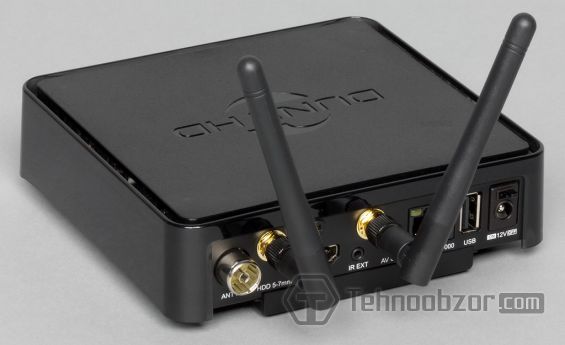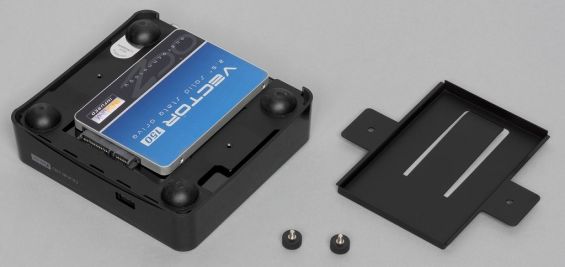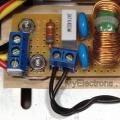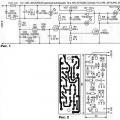Most of the video viewing is done on mobile devices these days. But true connoisseurs of good content remain loyal to stationary media players, because this is the only way to ensure high-quality and consistent work with projectors, TVs and other devices. Manufacturers are trying to further interest users and release devices with more powerful characteristics, such as for example 4K format.
The Dune brand has long been known among a large number of people in different countries. More than 10 years have passed since the world saw the first product of this company. Since that time, Dune has not lost its consumer, but only gained an even larger number of fans. This time, too, this company decided to please fans with a novelty - the Dune HD Solo 4K media player. From the name it is clear that the main "highlight" of the device is support for 4K video, the rest of the features will be analyzed in our review.
Dune HD Solo 4K Package Contents
The Dune HD Solo 4K box is noticeably different from the packaging of previous devices. It is quite durable, has a minimalistic design, there is a photograph of the device on the lid, and features and technical data in Russian and English are also indicated. Its dimensions are approximately 20x20x10 centimeters, and its weight is about 1.2 kg.
The media player with accessories in the box is located on two tiers. On the first one there is a manual for use and multilingual instructions for the correct connection, and in a special niche - the device itself.
Under the Dune HD Solo 4K there is a power supply unit with several types of plugs that can be changed depending on the type of outlet used. Nearby there is a remote control and several batteries for it. There are also wi-fi antennas, there are two of them and they are non-removable. There is an HDMI cable with a length of one and a half meters, a cable for connecting an analog audio and video signal, several brackets for installing and fixing the device on the wall, as well as an IR receiver with a cord for the remote control.
It is important to note that the complete set may vary depending on the region, the warranty period of service varies from 1 to 3 years, depending on the selected service package.
In general, it can be seen that the set is quite good, especially the HDMI cable, which is very important for working with both 3D and 4K formats, attracts attention. The presence of an analog cable is also a plus, although of course working with it is not the level of such a player. But it can serve as a backup connection.
Separately, let's say about the brackets that are needed to install and mount the Dune HD Solo 4K media player to the wall. Usually, the distance between their holes is 100 mm, but here for some reason only 96. True, on TVs with especially large diagonals, such a standard is not used in any case, so here we are talking about fixing the Dune HD Solo 4K to the wall behind the TV or where- somewhere on the side of it. In this case, an external sensor for the remote control will come to the rescue.
Dune HD Solo 4K - Media Player Design Review

The device itself is quite compact, its dimensions are only 40x134x134mm, which in itself speaks of its compactness. The sides and top of the case are constructed of black plastic, the lid itself is matte with a coarse-grained texture, and the edges have a glossy surface. The cover has ventilation holes and the company logo is applied. The bottom edge is completely metal.
On the front panel, in addition to the printed logo, there is a two-color status LED and a receiver for remote control signals. There is also USB 2.0, and all other ports are prudently located on the back.
Let's take a closer look at the Dune HD Solo 4K media player connectors:
- The power connector has a small on / off switch on top, which was not the case in previous models.
- The second USB 2.0 port is very close to the power connector, but it shouldn't be difficult to connect.
- The network port is equipped with several indicators, the player can be connected to the network using a wireless controller, which is equipped with two antennas, but you will not need them when working with a cable.
- The HDMI port is mainly used to connect all audio and video equipment.
- Composite output 3.5 mm (minijack type) for composite video and stereo sound.
- Standard antenna input for digital equipment.
The lower part is equipped with four rubberized feet. If you evaluate the general appearance of the Dune HD Solo 4K media player, then it leaves a fairly good impression both in design and in build quality. Together with the installed disk, the device weighs approximately 500 g.
The set comes with a remote control for controlling the player, similar to a TV one. Its body is entirely made of plastic. It is quite large in shape and fits well in the hand. The remote control has many buttons, they are grouped in such a way that after a short period of time you already get used to their use and press the desired one without peeping. Some function keys in the remote control, when compared with the previous model, have changed their places, they have no backlighting, and the upper part of the panel gets dirty and difficult to clean, which is definitely a disadvantage of this device.
Dune HD Solo 4K specifications and capabilities
The device uses the Sigma Designs SMP8758 chip, in this regard the device can be considered unique. For the first time, Dune developers use SoC from Sigma Designs to work with 4K format in their device. In the future, even changing the firmware of the Dune HD Solo 4K media player, nothing significant can be changed.
As for the technical component that affects the performance of the device, it is presented as follows:
| Cpu | Dual-core ARM, Cortex A9 cores overclocked to 1.2GHz (6000 DMIPS) |
| GP | absent |
| RAM | 1 GB |
| Flash memory | 4 GB |
| OS | Linux |
The player easily handles decoding of H.265 / HEVC files with 4K resolution (3840x2160 pixels) and frame rate of 30 fps. Of course, files up to 60 fps can also be played, but of course without quality guarantees, especially the HDMI video output itself is limited to 30 fps. Despite this, I was pleasantly pleased that the manufacturer himself indicates the parameters of 4K at 30 fps and HDMI 1.4b, without hiding information, as others like to do.
The device can work with 10-bit color representation. In any case, when using new formats, you should carefully study the encoding parameters, some files may not fit the characteristics of the Dune HD Solo 4K media player. The optimal choice is 4K video with a frequency within 30 fps and the H.265 codec, 10-bit color is optional.
More details about connecting to Dune HD Solo 4K:
- Audio and video equipment is connected via a regular HDMI input or via a minijack with support for analog stereo audio and composite video signal. Thanks to this combination, a high level of quality is obtained, more significant connection possibilities are revealed, and you can easily work with outdated equipment.
- Through the installed two USB 2.0 ports, you can connect local drives with exFAT, FAT, NTFS, EXT2 / 3/4 read and write file systems, as well as HFS +.
- A hard drive is connected to the SATA connector, you can also use a 2.5-inch SSD and no more than 7 millimeters thick.
- The network connection is carried out through a gigabit port or a built-in wireless 2-band adapter.
The external block provides power to the device, it is designed for 12 volts. Its input connector is equipped with a switch, but to completely de-energize, you must completely pull the power supply plug out of the socket.
A fan from ADDA is fully responsible for cooling the Dune HD Solo 4K media player, air exits through the grill in the upper part of the case on the left. There is practically no noise from the fan, it is even difficult to notice that it is there at all. For the convenience of users, an automatic search for updates is provided, upon finding which the device asks for permission to install.
Features of using the Dune HD Solo 4K media player

To get started with the Dune HD Solo 4K, you need to plug it in and connect via the HDMI input; to realize all the possibilities, of course, you will need a local network connection. You can connect a hard drive, and use a keyboard and mouse through the USB ports to make it easier to enter text and use navigation in some applications. There is also support for external optical drives. You can use unencrypted BDs, DVDs, and CDs.
When turning on for the first time, the user needs to configure the device parameters: language, video output mode, connection method, time zone, TV settings, etc. Anyone who has encountered this kind of technique will not be surprised at the Dune HD Solo 4K interface, since it is quite standard. The media player is able to synchronize with the Internet and independently manage the time setting, as soon as you set the time zone. In the video output settings, you can set the frame rate to change automatically and change some HDMI settings. In the audio output parameters, it is possible to change the settings for decoding, mixing and output of audio tracks. The network is connected using NAT technology or in bridge mode. Installing new applications can significantly expand the capabilities of the model.
The interface of the Dune HD Solo 4K media player can be easily changed, put the theme you like, change the look of folders, turn off or turn on animation. Separately, there is an option for controlling the sleep mode, setting the fan, if necessary, you can change the standard settings for updating the firmware and many other interesting parameters. In general, there are no difficulties with connecting and controlling the player, if something is not clear, you can always find the necessary information in the settings and controls manual that comes with the kit.
The device works with many sources:
- hard drive (located inside the case);
- external drives connected via USB (including optical);
- network resources with access via SMB and NFS protocols.
Dune HD Solo 4K pros and cons, price
The Dune company has not released new devices for a long time, and now we finally saw a novelty in the face of Dune HD Solo 4K. As in previous models, it has its positive and negative sides:
| pros | Minuses |
| High level of performance. | Restriction on playable formats. |
| Wide range of applications. | You cannot expand the capabilities by updating the firmware. |
| Support for 4K and 10 bit (color depth). | Relatively high price. |
| High quality TV tuner. | Using USB 2.0. |
| Wall mountable. | |
| Good build quality. | Limiting HDMI 1.4 and 30 fps. |
| The presence of a remote signal receiver for the remote control. |
It is worth saying that the Dune HD Solo 4K player came out, in principle, of good quality and has many advantages. Perhaps improving the processor, lacking a TV tuner and a full BD menu, helped reduce the cost of the device and attract more customers. Moreover, the restriction on formats negatively affects the possibilities of using the device. For 25 thousand rubles, as the device cost from the beginning of sales, HDMI 1.4 and 4K 30 fps is too much, especially with USB 2.0 and the lack of HDR support. However, for now, we can only hope for the future novelties of the manufacturer.
The price of Dune HD Solo 4K in Russia is 17,990 rubles.
Dune HD Solo 4K Full Specifications
| Design | Dimensions (edit) | 40x134x134 mm |
| The weight | 0.5KG | |
| Performance | SoC | Sigma Designs SMP8758 |
| Cpu | Dual-core ARM, Cortex A9 cores overclocked to 1.2GHz | |
| GP | absent | |
| VXP video processor | there is | |
| RAM | 1 GB | |
| Flash memory | 4 GB | |
| OS | Linux | |
| Network connection | Wi-Fi | 802.11 / b / g / n / ac, 2.4 / 5 GHz, 2T2R |
| Ethernet | 1 Gbps | |
| Connection | USB | 2x2.0 |
| IR extender port | there is | |
| HDMI | 1.4b | |
| audio coaxial S / PDIF output | there is | |
| Audio-video output | Minijack | |
| SATA HDD bay | there is | |
| Bluetooth module | No | |
| CI + slot | No | |
| Memory card slot | No | |
| Audio optical output | No | |
| Audio coaxial input (S / PDIF) | No | |
| Balanced audio outputs (XLR) | No | |
| Built-in tuner | DVB-T / T2 | |
| Format support | 4K | Only 30fps |
| HEVC 10-bit | Yes | |
| 3D TnB / SbS and 3D FullHD (BD3D MVC) | Yes | |
| HDR | No | |
| audio formats | MPEG / MP3 / MPA, AAC, WMA / WMAPro, APE, FLAC, WAV, WAV Pack (WV), ALAC, OGG, SACD, AC3, Dolby True HD, Multichannel PCM | |
| video formats | MKV, MPEG-TS, MPEG-PS, M2TS, VOB, AVI, MOV, MP4, QT, ASF, WMV, ISO, BDMV, VID | |
| Additionally | Opengl | No |
| Auto frame rate switching | Yes | |
| Built-in Hi-End DAC | No | |
| IPTV and OTT services | Yes | |
| Dune HD GUI | there is | |
| Dune HD Apps | PHP | |
| Cataloguer | there is | |
| Option to quickly access recently played content | there is | |
| Full Blu-ray menu support | Yes | |
| Installing Android Apps | No | |
| Playlists | M3U, PLS | |
| Remote control | there is | |
| Power adapter | 12V | |
Dune HD Solo 4K Video Review:




